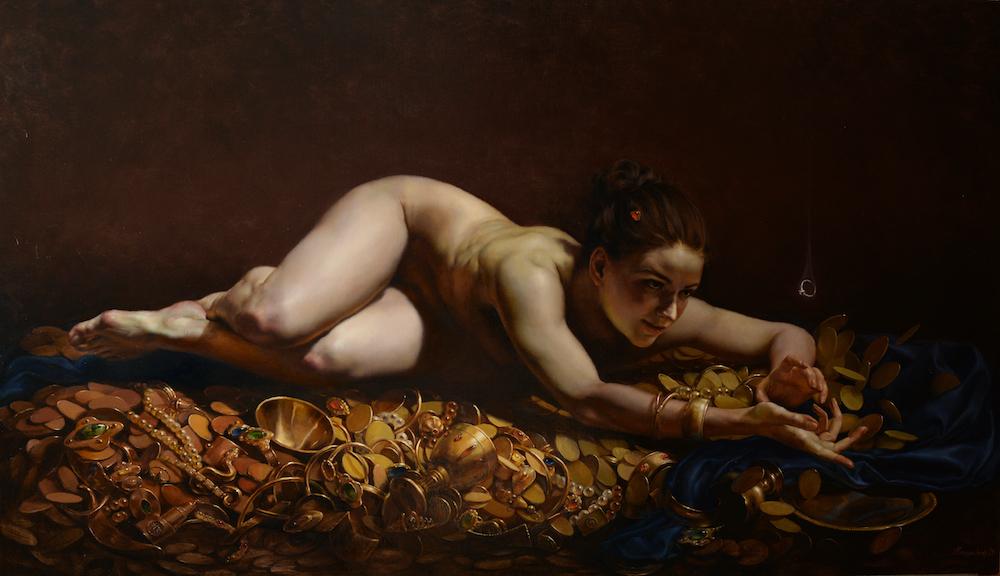Enigma Wrapped in a Mystery
December 21, 2022

The Art of Daria Kropacheva
By Leeza Arkhangelskaya, Owner East West Fine Art
The ability to create artwork has always been a mysterious force, given only to humans. Yet not all artists are created equal. Certain artists are so historically and culturally important that they are remembered for thousands of years.
What is the difference between the artworks that they create? What is the difference between “high” and “low” art?
Nowadays our views on art are very liberal, but in the 17th century, the French Academy of Fine Arts set a clear distinction between” Low” and “High” art. “Low” art depicts easy to understand subjects like portraits, landscapes and still lives – art for the masses. “High” art portrays human figures (in the likeness of God) in historical, religious, and symbolical contexts, and thus requires a certain level of education and social status to understand. High art elevates the human spirit, while low art caters to our primitive instincts.
According to this definition, the art of Daria Kropacheva certainly falls into the category of art for the elite. It satisfies the highest level of mental and spiritual aspirations of the most discriminative viewer.
And what’s even more important – her paintings are harmonious, beautiful, and emotionally charged.

Leeza Arkhangelskaya, owner of East West Fine Art has recently had an insightful discussion with Daria Kropacheva, an incredibly mature artist, especially considering that she is only 34.
We want to share with you Daria’s views on art, its complexity and controversy, and its role in the modern world.
LA: You are an artist following the classical tradition, while many contemporary artists are going in a completely different direction. How do you see yourself in the modern art world?
DK: Many critics define me as an artist who revives the classics in a modern way. Classics in my eyes are only an instrument, a technique which I use to depict a new character, a new theme, or at least a new take on a classic plot. The contribution that I make to the contemporary art world will be determined only by time.

LA: Your paintings are filled with symbolism. Do you expect viewers to decipher them?
DK: Some paintings are very easy to understand, some are puzzles. I do not have a goal that the viewer would unravel my idea embedded in the painting, I paint for the viewer to enjoy the image or philosophy behind the proposed topic. Everyone can see it differently. But when someone manages to read what I put in it, is very rewarding.
LA: What does “beautiful” art mean to you? Do you think that modern art should be beautiful?
DK: Beauty in art, as in everything, is subjective and depends on the time and culture and individual preferences. Beauty for me is everything. But in art, beauty is not the most important aspect. I think the purpose of art is an idea. Make the viewer to stop and evoke emotion. Beauty is not necessary for this. Artists in today’s world have freedom of expression. And everyone chooses his own method to convey the most important message to the viewer.

LA: What message do you wish to convey to your audience?
DK: I suggest looking at a given topic from an unexpected angle. I ask questions: Do you agree that this can be the case? Why not? What do you agree with? And what is your world like? Topics for discussion appear randomly. It’s something that excites me now or something that has been bothering me for years.
LA: How do you research a topic before you get started?
DK: The subject is often based on certain knowledge. I can already imagine how I will depict it and what I want in the painting. But while working, I can add some elements that help to reveal my idea. I bring up all the information I can find about symbols, about history. And yet, sometimes I paint just from imagination.
LA: Do your paintings reflect current economic, social, or political movements?
DK: Yes, I sometimes I subconsciously embed current topics into my paintings. I live in the modern world and its issues affect me. And yet I consider current issues being as old as humanity.

LA: Could you give us some insights into two of your paintings?
DK: In “First Spark” I’ve created a new mythological Goddess who is responsible for bodies after death. This Goddess pulls out the last drops of life in the form of pearls. In solitude, in cramped space, she creates a new life. No one knows about this. Everyone has long forgotten about the person that they once loved. Natural processes do not stop. In this small world of hers, the Goddess creates her miracles. She collects pearl after pearl and raises them above – to catch the light – for a new life to be born. What happens next? It’s no longer her responsibility. Her task is to convert the dead into something that gives life.

DK: In the painting “Freedom” I portrayed a girl as a personification of the word. Cold, humble but at the same time doing her thing for the thousands of years. Freedom in human history has never been given for free. It was captured, conquered, defended by unearthly forces. The girl in my painting seemed to touch the wing of a bird and give freedom through blood, or red paint. Red is the color of revolutions.

Daria Kropacheva’s artwork is exhibited at East West Fine Art, in Mercato. 9115 Strada Place, #5155 Naples, Florida 34108. www.eastwestfineart.com info@eastwestfineart.com
